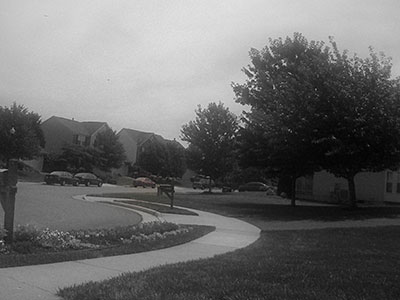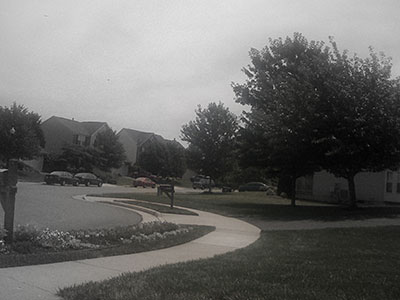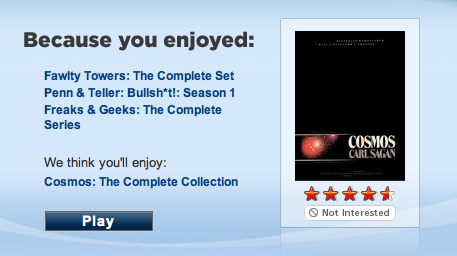A few moments ago, I just had a very interesting and unique experience. I saw in black’n’white. I’d never had this happen before in my life. First I’ll describe the experience, then how I did it, which, curiously enough was repeatable.
“It was clearly not imagination… It was a greyscale world that I physically saw, like a black and white movie, but a zillion times sharper, far more dynamic range, and in 3D.”
With the totally unaided eye, my brain saw my surroundings, in broad daylight, in black and white. The only exception was that objects which were normally bright red had an ever slight red hue to them, but it was only brilliant red objects that did this.
The effect lasted about 7-10 seconds in duration before the color faded back in, almost as if the saturation was being brought up from near nothing to normal.
To convey the effect, this is much like the image I saw:

When I moved my eyes to look at other parts of the scene, the effect diminished, but if I kept focusing on one spot, like a child’s staring contest, the effect would hold longer. This was very much the inverse of the behavior of an after-image, where if you stay still it fades, but if you rapidly blink, it returns.
The black and white effect composed of the entire field of view. And as it gently faded back to normal, it affected more of the center of the field of view first:

It only took 2-3 seconds for normal color to return. There was no pain or any form of discomfort before, during, or after. I’m in very good health.
It was as if the signals from the cones were being ignored by the brain, but the signals from the rods were fine. I remember that the detail was astounding, and that the tone of the grass was very similar to the sky, though I’ve been unable to represent that as closely as I’d like in my photographic simulation.
I’m certain you’ve personally woken up in the morning and upon your eyes adjusting to the light have seen the image fade in, not focus, but as your brian assembles bits of the information into meaningful images, like it’s adapting to light after not being exposed to it for a long while.
Here’s how I did it.
I’m going to err on the side of giving too much information, some that might not be relevant, primarily because I don’t know what actually caused it. However, I was able to recreated it, on demand, several minutes later by experimentation; the effect lasted even longer. It was wondrous.
Being inside for the better part of the morning, I figured I’d go outside an lay in the sun for a few minutes. So, I lay down on my back on our driveway which has a slight incline. It was about thirty minutes past noon, and the sun was slightly overhead just off center to my right, enough that it was still bright enough that just closing my eyes was uncomfortable, so I criss-crossed my arms over them to put them in shadow, though I could still tell it was very bright out with my eyes closed. The weather was 89°F, I was in direct light, and there were few clouds in the sky.
I rested this way for about 10 minutes, and I did so just to the point where my eyes were fully relaxed and no longer concerned about the brightness of the light though my eyelids. Also, I wasn’t quite drifting off, but relaxed as you might be just taking in warmth of a nice day at the beach.
What led to the discovery was that I heard a car drive by and so I sat up quickly, opening my eyes. Two things stood out. One, this gave me a slight head-rush, though I’d describe it weak at best. Two, my eyes had not adjusted to the light fully. And, although while bright, it wasn’t uncomfortable, there was no blinding whitewash, no pain, and no caused for squinting required — I was looking away from direct light.
That’s when I noticed the scene seemed extremely washed out and monochromatic; it looked like a black and white photograph.
Thinking my mind or eyes were playing tricks on me, I moved my eyes, but the effect lasted longer than a second, though faded as I looked at more “new” material in my field of attention.
The reds came rushing back in first, with greens right after. It wasn’t one color than another, it was overlapped. I became visually more aware of reds, as that happened, greens started replacing the grey tones as well, and by the time greens were normal, the other colors like purples and blues from the nearby flowers in our garden were already present.
This part will be hard to describe because there’s no English equivalent for it, but it wasn’t like I was seeing in black and white, but rather the absence of color.
I know that sounds identical from a logic standpoint, but the perception was an absence of something, not the presence of something. Intellectually, I knew there had to be color, I just wasn’t seeing it.
It was a greyscale world that I physically saw, like a black and white movie, but a zillion times sharper, far more dynamic range, and in 3D.
It was clearly not imagination, nor dream, it was very real and perceptible.
That’s what made me want to try and repeat it.
Though this time around, if I could get it to work, I’d plan a more scientific excursion. So I selected an area of our yard with brilliant colors, our flower garden, which would be my baseline.
First, I waited about 5 minutes and looked at the area, taking in all the things I should be expecting to see. The area was already in normal color after the effect had faded long ago, but I wanted to be sure.

So, I laid back down with the intention of trying to get the head rush. I shielded my eyes in shadow, and waited for them to relax and get comfortable, and then waiting a moment, quickly sat up and stared at the area I knew had colorful flowers, a bright red car, and tons of green grass. I made sure I would focus only in one area, trying to stare out to infinity, much as you’d do for those 3D posters, though I was more trying to keep my eyes in a relaxed state because I wanted them in focus.
The preparation this time around took merely a minute or two. The head-rush was again weak from sitting up quickly. I turned in the direction I had planned and opened my eyes.
It’d worked.
The effect returned just as before, but lasted this time about 20 seconds and the effect was just as strong until I couldn’t help myself and look at the astounding detail in scene around me, which caused the effect to fade.
Since I had more time to study the scene, this is when I actually noticed the reds within the black’n’white image in my head. The B/W effect seemed more pronounced when I didn’t move my eyes, relaxing them.
When I turned to look at other things, color would seep in, and if I held my eyes relaxed in the same spot, the color would fade back out partly, much the same way as you can make objects in your blind spot vanish by holding your vision still long enough. That same kind of fading away was what I saw, but with color.
I suspect the effect is caused less by the head rush and more by the eyes being exposed and conditioned to bright light (even with the eyes closed, or maybe the red light through the eyelids saturates the cones like a red filter, though I did not see a green after image). When the eyes are opened, there’s a whole rush of visual information, and I suspect the brain is compensating for the overload by taking in shapes, detail, and tone and then overlaying color after the signal settles. I wasn’t aware that visual processing of color was an independent process.
This led me to two very interesting side thoughts.
One, I’ve always wondered if while under hypnosis people really saw things but said they didn’t, or whether their honestly perceived it. I now know it’s possible to perceive things differently than the visual input as actually providing.
Two, the black and white image was astonishingly detailed in greyscale, much like an Ansel Adams image. Being able to produce this effect on demand to view how a scene might be photographed in black and white is a fantastic tool to have in one’s photographic arsenal.
I hope science doesn’t declare this is bad for you, because I’m going to do it again!
[UPDATE: I can’t get it to happen inside, seems bright sunlight is required.]






